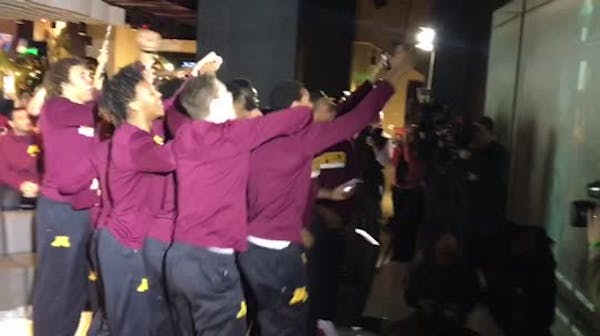There was a need to review the exploits of the 1988-89 Gophers basketball for Monday's column on the Coffey connection between that team and this season's surprising run by the Gophers to the NCAA tournament.
Richard was a standout junior on the inside for the Gophers on the route to the '89 tournament, and son Amir has been a standout freshman on the outside for the current Gophers.
Kevin Lynch was a standout freshman guard for the '89 Gophers, and his nephew Reggie Lynch has been a standout junior center for the current Gophers.
Inside, outside, freshmen, juniors … all these might be oddities with these turnaround teams, or not worth mentioning, depending on your point of view.
One thing I did find was a short piece from a couple of years on the 1988-89 Gophers that stated this was the first team to reach the "Sweet Sixteen.'' True, the phrase didn't become part of the national sports jargon until the NCAA completed its crazed bracket expansion, doubling in size 32 teams to 64 in a six-year period (1979-85), but there's also this:
The Gophers did have two previous appearances in the NCAA's Round of 16, both after Big Ten championships: in 1972 with Bill Musselman and in 1982 with Jim Dutcher.
The field in 1972 was 25, made up of conference champions and smattering of independents. Repeat: If you were in a conference and didn't win it, there was no bid to the NCAA tournament.
The lone conference to determine its official representative with a postseason tournament was the Atlantic Coast Conference. You can still get old-timers on Tobacco Road to weep for those days when that tournament was cut-throat beyond imagination since it was the only route to the NCAA field.
There were nine first-round games and seven teams with a bye into the Round of 16. The Gophers received one of those as the Big Ten champions. Florida State, an independent, defeated Eastern Kentucky (champ of the Ohio Valley) 83-81 in the first round, then whacked the Gophers 70-56 in the not-yet-Sweetened Sixteen.
That Gophers team still gets credit for an NCAA victory, since it defeated Marquette in the third-place game. Yes, the NCAA still hosted third-place games in its four regionals, hoping that the fans of the teams who had lost in the Round of 16 would stick around and help fill the arena.
In 1972, March Madness was more like the March Minor Disturbance on the national sports scene.
That was the Gophers' first-ever appearance in the NCAA. The previous Big Ten title had come in 1937, 35 years earlier and two years before there was an NCAA tournament.
The field had expanded to 48 by the time the Gophers won the Big Ten again in 1982. Non-conference champions started being gradually allowed in the tournament in 1975, and then TV started to get more interested and so did the NCAA in receiving millions of dollars.
The Gophers were a No. 2 seed in the Mideast Region, behind Virginia and Ralph Sampson. They had a bye in the first round, then played terribly but survived UT-Chattanooga, the Southern League champ, 62-61 in the second round.
That sent the Gophers to Birmingham for the Mideast Region. Again, they weren't sharp and lost 67-61 to Louisville in what by then was the Sweet Sixteen. I remember trying to write a column on press row, as Gene Bartow's Alabama-Birmingham newbies were ending Sampson's career with a 68-66 upset.
The Gophers' third all-time trip to the NCAA was provided by that '89 team. You might suggest that going 9-9 and finishing fifth in the Big Ten, and getting an 11-seed, pales in comparison to going 11-7 in the Big Ten and landing a fifth seed for Richard Pitino's first NCAA team.
All I'll say about that is the four teams finishing ahead of the Gophers in 1989 were Illinois (a No. 1 seed), Indiana (a No. 2), Michigan (a No. 3) and Iowa (a No. 4). The only team among the five representing the Big Ten to lose in the first two rounds was Iowa.
The Big Ten was 9-1 on the opening weekend, and 16-4 overall, with the last of those losses coming with Michigan beating Illinois 83-81 in a fantastic national semifinal. The Wolverines then beat Seton Hall 80-79 in overtime to win the NCAA title.
There was no Rutgers, or Nebraska, or Penn State to kick around on a Big Ten basketball court. "Best conference in the country without debate,'' said Richard Coffey in Monday's column, and he was understating the power of the Big Ten in 1989.
Cavaliers feel better prepared for playoff stage after '23 flop, face Magic in first-round series
Olympic organizers unveil strategy for using artificial intelligence in sports
Former Cooper football star Howard transfers from LSU to Gophers
Chinese Grand Prix could deliver drama to F1 and slow Verstappen's victory march

